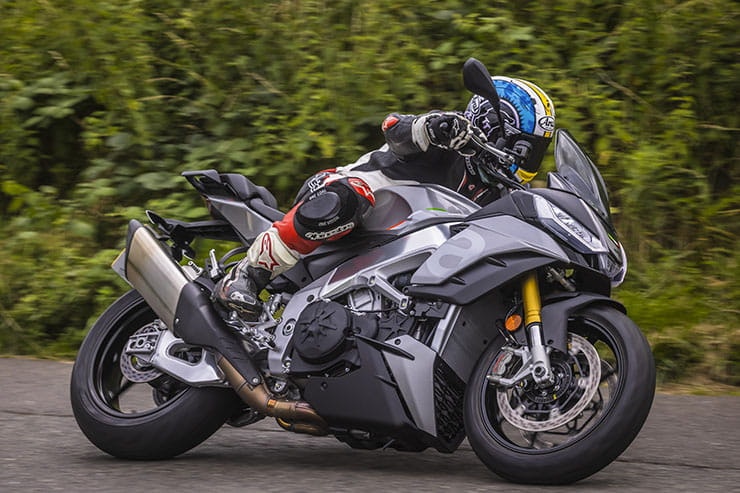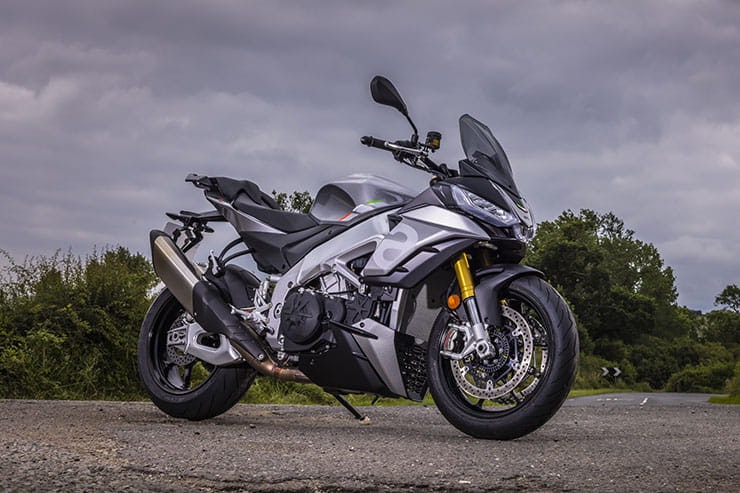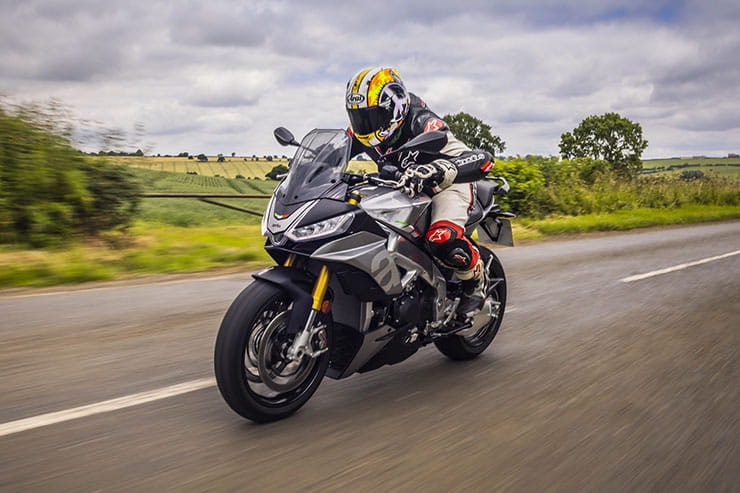Aprilia Tuono V4 (2021) - Review
BikeSocial Road Tester
06.08.2021
Historically, Aprilia have always produced multiple variants of their Tuono. There were ‘Factory’ spec, standard or limited edition R versions back when their big-cube naked was a twin-cylinder machine. The different models were relatively similar, with tweaks made to the suspension and brakes to create the (usually slightly lighter) sporty versions. However, for 2021, Aprilia has produced two quite different models, stretching them and their USPs further apart.
At the ‘high end’ is the Factory version that we tested on track at Misano in Italy earlier this year. This comes equipped with Öhlins Smart EC 2.0 semi-active suspension, slimmed-down bodywork and, for 2021, built-in winglets, while the ergonomics are more directed to sporty track riding. A fantastic bike designed for fast riding and track days.
But the bike we have on test here is the less expensive Tuono, distinguishable by its larger top fairing, higher bars, a comfier seat, lower pillion pegs and even pillion grab handles… you be forgiven if describing this Tuono V4 as ‘sensible’.
Engine performance is the same across both models, but the standard version comes suspended on fully-adjustable but conventional Sachs units (the steering damper is Sachs, too) rather than on electronic Öhlins.
Comfort and practicality
New dash, electronic rider aids
Power and sound
A little too soft for track use
Colour a bit bland
Aprilia Tuono V4 (2021) Price
How much is the 2021 Aprilia Tuono V4? £15,500, available in Glacier White or Tarmac Grey.
Normally, we would instinctively compare a Tuono to similar super-naked machines such as the KTM 1290 Super Duke R, but this isn’t the case with the 2021 Tuono V4. I believe we now must look at other sporty touring-orientated machines like BMW’S 1000XR (£14,210) and Kawasaki’s Ninja 1000 SX (11,299).
The base BMW S1000XR is cheaper than the Aprilia and comes with semi-active (Dynamic) suspension as standard, but once you add the goodies necessary to match the Aprilia, the BMW becomes slightly more expensive. The top spec S1000XR TE (£16,150) is more comparable, however, and comes with a few added extras over the Aprilia like a centre-stand, hand guards and heated grips.
Kawasaki’s Ninja 1000SX is tempting on price and is an excellent bike. Even a fully loaded SX with panniers it is cheaper than the Aprilia (£13,349) but is also down on power and performance. An exciting alternative to the SX is Kawasaki’s supercharged H2SX (base model: £15,899).
Power and Torque
Like every motorcycle manufacturer, Aprilia has had to meet Euro-5 emissions for its 2021 models. A relatively easy way to do this would have been to increase engine capacity and throw in a new 1099cc V4 based on the race RSV.
Instead, the factory have stayed with the 1077cc unit, and cleverly reduced emissions with a lighter and completely new exhaust, and new fuelling. Despite hitting Euro-5 the Noale-based team has managed to attain the same power and torque as the previous model: 173bhp/129Kw @ 11,350rpm and 121Nm/89ftlb @ 9000rpm respectively.
These impressive figures may lack the magical 200bhp target of some of the Tuono Factory’s rivals like Ducati’s Streetfighter and MV’s Brutale, but the revised engine revs 300rpm higher, which according to Aprilia gives a slight increase in top speed.
Engine, Gearbox and Exhaust
I have mentioned this in previous road tests of recent Aprilias, but the team who look after the manufacturer’s electronics, fuelling, and electronic rider aids deserve a pay rise. They produce some of the best and most refined on the market – as evidenced by the immaculate throttle response and quick-shifter on the Factory version – and this continues onto the more road oriented Tuono. It is faultless.
The now old Tuono was excellent, too, and it would have been easy for the fuelling and electronics department to put their feet up and enjoy long lunches. Instead, they fitted a new Magneti Marelli ECU, essentially the brain of the bike, which is now four times faster than the previous ECU. This produces one of the most sweetly fuelled bikes on the market.
Excellent throttle response and a super-smooth quick-shifter transmit confidence to the rider. Despite its intimidating 173bhp power figure you can trickle the Tuono through town as easily as a twist-and-go Vespa. Alternatively, you can dial in all that power, pushing the grip and the electronics’ intervention levels to their limits while feeling every degree of the throttle. The connection you feel seems personal, intimate, one-to-one – like bumping into an old mate you’ve not seen for a while and instantly falling back into the same jokes and banter.
It allows you to make the most of the V4’s 173bhp. After all, there is no point in owning a fearsomely powerfully motorcycle if you can’t use all its horses, and while the Aprilia’s on-paper figures may not catch the headlines like some, every bhp is thoroughly usable.
The (lean sensitive) rider aids that impressed so much on track on the racy Factory Tuono, translate well to the street, too, albeit with the focus switched to the road modes, Touring and Sport. For this test, I deliberately left the V4 in the most intrusive mode, Touring, for the majority of the road miles. When pushing hard, you can feel the rider aids working, holding you back and controlling the power and (eventual) wheelies. Step up the pace, drop the Tuono onto the edge of its tyres, dial in the power, asking for all 173 of those Italian horses, and the clever electronics simply take over. There is no stutter or backfire, they simply give you reduced power whilst you’re lent over, then feed horses back in as you push the bike upright. In Touring mode in perfect conditions, you can feel it working away in the background. It’s like learning to cook with Jamie Oliver quietly offering instructions when you get it wrong.
The rider aids are not there to hinder the fun, but instead make the ride safe, which arguably makes it more rewarding. What’s more, the electronics are easy to change on the move, and you can even deactivate the TC and Wheelie Control for some one-wheel action, which the V4 performs easily and without hesitation should you wish to take the risk.
Talking of risking your licence, it’s worth mentioning the exhaust. The new lightweight system is Euro-5 homologated and at low revs and tick over doesn’t sound anything exceptional. Once the revs increase, however, so does its clatter and volume, occasionally accompanied by the odd backfire as the ignition cuts during a clutch-less gear change. It’s a wonderful noise but open up the throttle and the locals will certainly hear you before they see you.
Handling, Suspension and Weight
The main difference between the Factory and the standard versions of the V4 (the latter is the one we have on test here) is the suspension. They both use identical frames and the new underslung swing-arm which increases rigidity by 48%, but that is where the similarities end. Our test Tuono comes suspended on fully adjustable units from Sachs (including the steering damper), whereas the Factory uses the Öhlins Smart EC 2.0 semi-active suspension system. Tyre choice is also slightly different; the rear is a 190/55 Pirelli Diablo Rosso 3, not a larger (190/50 or 200/55) more track-focused Pirelli Supercorsa. This means the Sachs system doesn’t change its setting on the move and changing the electronic rider modes has no effect on the suspension. If you want to change the suspension settings, you now must use old-fashioned tools. Speaking of which, it’s a shame there isn’t a remote pre-load adjuster to make compensating the weight of a pillion much easier.
You immediately feel the difference between the road-focused V4 and the Factory. This V4 is more plush and comfortable. The ride quality is forgiving and smooth – catering much more for the road than track. Don’t be mistaken, though, this Tuono can still cut it. Taller bars allow you to throw the V4 around with relative ease and there is no getting-to-know you period; you can simply jump on and ride fast (or slow), knowing you have some of the most effective rider aids on the market on hand should you get a little carried away.
However, if you intend to take the Tuono on track, which it’s more than capable of, you’ll need to adjust those Sachs units to suit. When you start to make full use of the rider aids and power, you’ll discover the compliant, road-focused suspension is on the soft side as the pace intensifies. Hard acceleration will get the rear squatting and needs more support on track. Jump on the impressive stoppers and the forks quickly move towards the end of their travel, sending the ABS into overtime as it controls the rear wheel lift (depending on the riding mode).
Comfort and Economy
This is where the Tuono truly excels and takes a clear step away from the Factory.
An easy-to-read full colour TFT display is the same as the Factory version, giving you plenty of information, but this is where the similarities end. This Tuono has an 18 per cent larger top fairing and a taller screen which make a significant difference. It may not appear huge, but the level of wind protection is impressive. I stand 5’7” by the way.
The ergonomics and riding position are less radical thanks to raised bars, and the pillion gets a larger, more comfortable seat, solid looking grab handles and lower pegs, which also feature neat little bungee hook mounting points for soft luggage (side panniers are an optional accessory).
While power and torque figures are the same as the Factory version, the Tuono has a taller sixth gear, reducing the revs at motorways speeds, not forgetting cruise control that comes as standard, operational from the top of the left ‘bar.
I could easily roll out some serious miles on the Tuono. It’s a big step in terms of comfort over the Factory and is probably the most mile-hungry Tuono to date. The only slight negative is fuel consumption. Aprilia quote just under 40mpg and on test I was achieving mid-30s only – though I was riding hard. Theoretically, the tank should give around 160 miles before needing a refill, but realistically you’re going to need to start looking for petrol stations at around the 130-mile mark. That’s long-before your well-cossetted body parts would be asking for a rest.
Aprilia Tuono V4 (2021) Brakes
Stopping power is generated by the same M50 Brembo callipers as the Factory version (and the previous generation Tuono). Although unchanged the power and feel are superb and, from my previous experience, don’t suffer any fade on the track.
Three-level cornering ABS, designed in partnership with BOSCH, is new for 2021 and works in line with RLM (Rear Lift Mitigation). The new electronics mean the algorithms and calculations are quicker, improving the Cornering ABS further. On track, or just for a few giggles, the rear ABS can be deactivated.
New for this year is AEB (Aprilia Engine Brake), which adjusts the level of engine braking and is independent of the selected maps. This allows you to trim the engine braking strategy to how you ride and the prevailing conditions.
Rider Aids, Extra Equipment, and Accessories
The new Magneti Marelli ECU, which operates faster than the previous ECU, is linked to the 6-axis IMU, and is the super-sharp new decision maker in the mix of multiple rider aids. Unlike some of the competition all the rider aids are standard – you don’t need to purchase an additional ‘package’ – and are the same as the top-spec Factory V4 version.
ATC (Aprilia Traction Control) has eight levels and can be changed on the move. This is easy to do via the toggle finger-and-thumb switch on the left bar. There is AWC (Aprilia Wheelie Control), which has five levels and like the TC can be changed while on the gas. The lower levels allow the front to lift slightly and none abruptly cut the ignition. There are three different engine maps (AEM), plus the mentioned engine braking levels (AEB).
As before there is Aprilia Launch Control (ALC) and Aprilia Pit Lane Limiter (APL), not forgetting Aprilia Cruise Control (ACC). And lastly, the brilliant (AQS) Aprilia Quick Shift, which has a new operating strategy for 2021 that even allows downshift with the throttle still open. It’s an impressive line-up of electronic goodies that majors one easy access and being straightforward to operate.
As you’d expect, Aprilia offers a range of racing parts, exhausts, brake guards, and carbon front air vents which look very trick. But there are more practical options like side panniers, 22.5l capacity in total, a USB port, and even a ‘comfort’ touring seat.
Rivals
Aprilia Tuono V4 (2021) Verdict
I was mightily impressed with the Factory version of the Tuono on track and knew the standard version with its more-road focused ergonomics would also impress on the road. In many ways it is a better and more versatile bike than the Factory edition.
As with the Factory, the fuelling, throttle connection and rider aids are some of the finest on the market. Handling is typically impressive and the manually-adjustable suspension only needs tweaking for the added weight of a pillion or the demands of the track and sticky track rubber. The Tuono offers a new practicality as well one heck of a bucket load of entertainment. The V4 has become one of the most enjoyable engines in any sector – and sounds fantastic too.
I’m unsure on the drab-ish looks, which lack the desirability of the Factory, and I’d like a larger tank range given the excellent comfort levels of this excellent bike, but this is a really big step by Aprilia to produce the most practical Tuono to date.
Aprilia Tuono V4 (2021) Technical Specification
To learn more about what the spec sheet means, click here for our glossary
Photos by Jason Critchell
What is MCIA Secured?
MCIA Secured gives bike buyers the chance to see just how much work a manufacturer has put into making their new investment as resistant to theft as possible.
As we all know, the more security you use, the less chance there is of your bike being stolen. In fact, based on research by Bennetts, using a disc lock makes your machine three times less likely to be stolen, while heavy duty kit can make it less likely to be stolen than a car. For reviews of the best security products, click here.
MCIA Secured gives motorcycles a rating out of five stars, based on the following being fitted to a new bike as standard:
A steering lock that meets the UNECE 62 standard
An ignition immobiliser system
A vehicle marking system
An alarm system
A vehicle tracking system with subscription
The higher the star rating, the better the security, so always ask your dealer what rating your bike has, and compare it to other machines on your shortlist.


